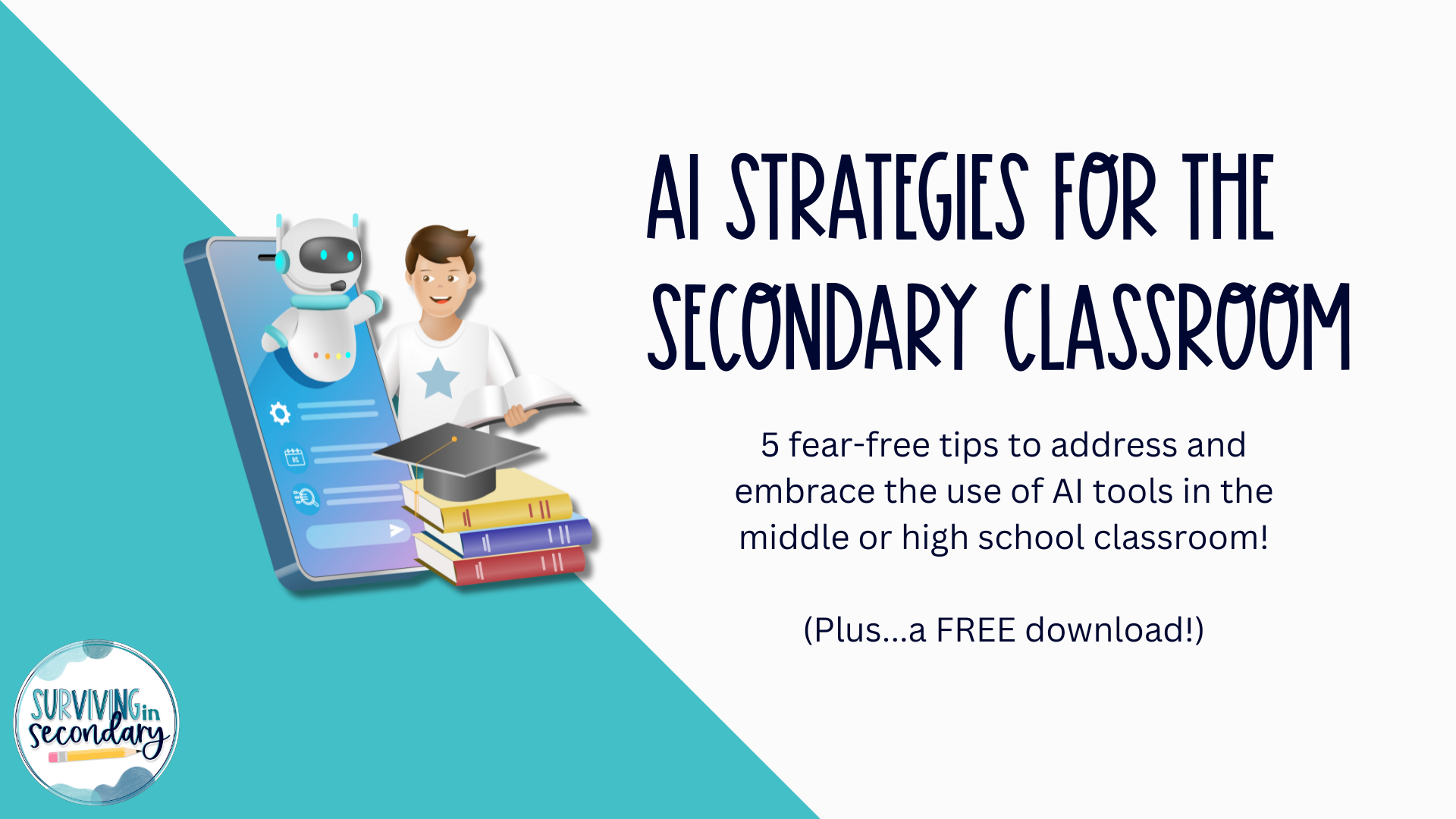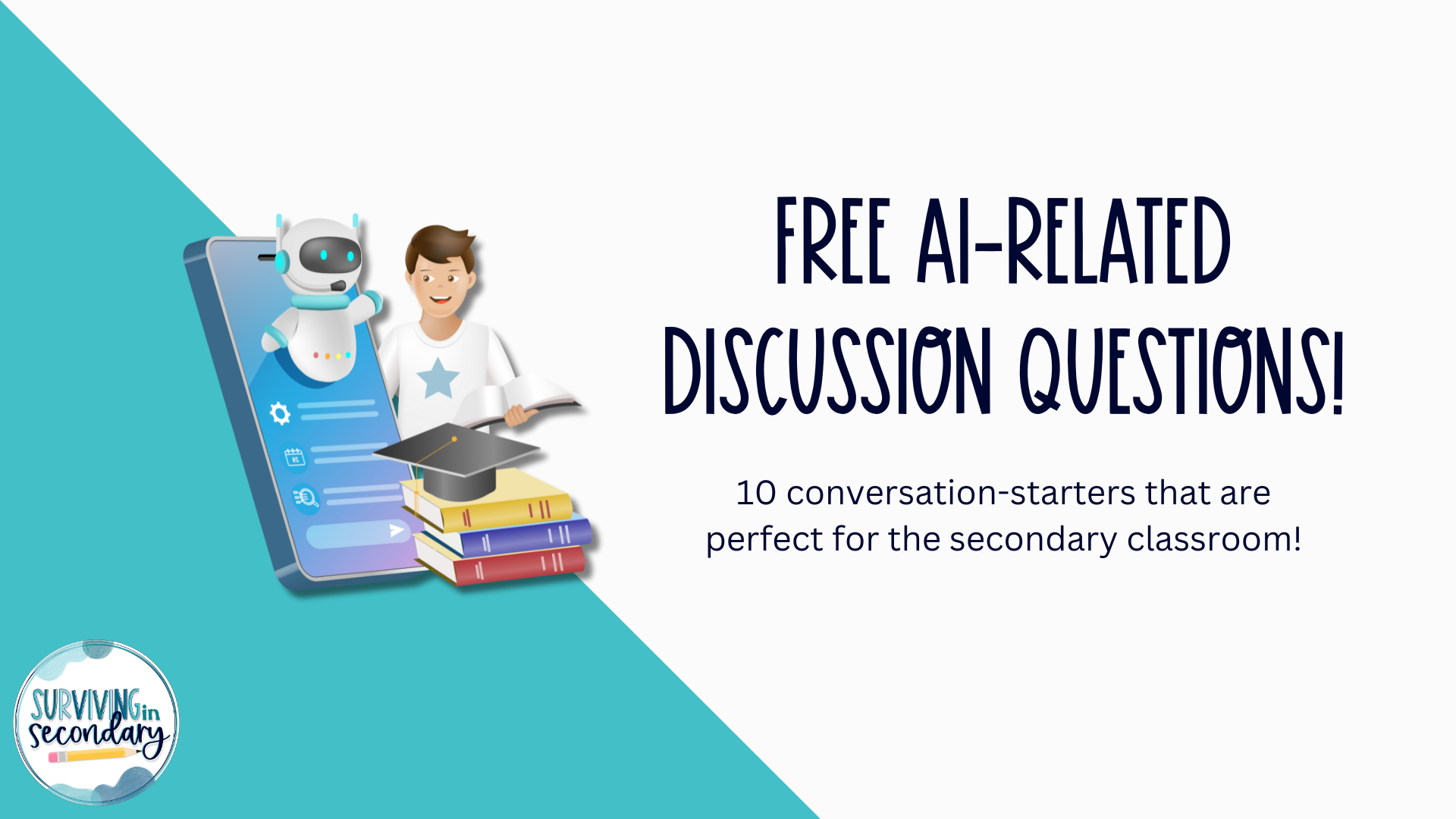5 Strategies for Addressing and Embracing AI in the Classroom

By Jess @ Surviving in Secondary
ChatGPT. Google Bard. Bing Chat. Jasper. ChatSonic. These days, the list of new AI platforms seems a mile long. Everywhere you turn, there are articles touting the “life-changing” features or bemoaning the “world-destroying” flaws. And if you’re a secondary teacher? Those doomsday pieces about AI catalyzing plagiarism en-masse and eliminating the need for critical thinking can strike a not-so-lovely chord.
If you’re worried about the impact of AI on your classroom and don’t know where to start, you’re in the right place. We felt that way, too – until we did some digging and figured out ways to work with AI instead of against it. Read on for five concrete strategies to address (and maybe even embrace!) AI in the middle or high school classroom.
1. Do your research!
If you want to address AI in the classroom, you first need to solidify your own understanding of the topic. We know that this prospect can be intimidating, especially since AI is changing every day! You don’t need to be an expert, but you do need to know the basics.
For an easy-to-digest overview, we highly recommend this "AI, Explained" video from the Wall Street Journal. In just 13 minutes, you’ll gain a foundational understanding that will help you have these conversations with students and colleagues.
2. Be proactive, not reactive.
AI is here to stay, and hiding our heads in the sand won’t help. We highly recommend bringing the topic up to your students proactively instead of hoping it won’t come up and forcing yourself into an on-the-spot reaction. Let students know that you are aware and experiencing this new frontier of technology alongside them — they will appreciate your willingness to dive in!
Not sure how to broach the topic? Our “I Spy AI” lesson is the perfect way to tackle the topic in the secondary classroom. This tried-and-true resource will guide students through an essay analysis where they will have to determine if the author was a student, a teacher, or ChatGPT. The twist? All three essays were actually written by AI! Complete with print-and-go graphic organizers, discussion questions, slides, and even video recommendations, this lesson is sure to be a success!
3. Give students a voice!
Our secondary students have been raised in a tech-saturated world. They are hungry for authentic conversations about digital advancements and what they mean for their lives. This topic doesn’t have to be just another “extra” – it can be a great addition to your existing standards-based discussion practices. Center your next Socratic Seminar, fishbowl discussion, or chalk talk on the topic of AI and its place in modern society. You will be surprised by how deeply students engage with the content. Plus, as you monitor the conversations, you will probably learn a thing or two!
If you want to provide some prompts to get students started, click HERE to receive a FREE 10-question discussion bank designed to spark meaningful, relevant conversations about AI!
4. Develop a policy that can bend without breaking.
You probably already have a plagiarism policy in your student handbook or course syllabus. But have you considered adjusting it to meet the challenges brought on by AI? A strong but malleable policy will be your best friend. Since AI is ever-changing, we need our policies to clearly define rules and consequences while still remaining flexible enough to address ongoing advancements. The key phrase to remember here? “Bend, don’t break.”
Your procedural needs will vary based on your classroom context, but we recommend hitting a few key points in your 21st century plagiarism policy.
Acknowledge the potential acceptable uses of AI (a complete ban makes it more tempting!), like creating outlines, brainstorming sentence starters, or identifying key topics for further research.
Define your absolute no-gos, such as submitting an AI-generated essay, citing ChatGPT as a source, or using AI to rewrite a paper.
Identify tools you will use to check for AI-based plagiarism. We love AI Writing Check for this purpose!
Add a disclaimer that allows room to address new and…erm…innovative? forms of plagiarism. Even a simple phrase like, “This policy is subject to change based on technological developments that may arise throughout the school year” can help cover your bases.
Determine fair and consistent consequences for plagiarism. Will students get an automatic zero? Will they be able to redo an assignment with a grade penalty? Will there be a formal disciplinary report or call home? The specifics are up to you and your school, but you should be prepared to follow through, every time.
5. Learn to use and love AI tools!
Model appropriate and ethical AI use by making it part of your professional practice! Stuck on how to best word an email? Give ChatGPT a prompt like “Brainstorm an email from a teacher to a parent about a student's missing project” and use it as a starting point. Try a tool like QuestionWell to create comprehension questions and export directly to Blooket or Kahoot! Use Dall-E to generate unique images to use as creative writing prompts.
The possibilities are endless, and more ideas are popping up all the time. We love following @joyfulnoiseteaching on Instagram for her tech-y teacher tips! Even a quick Google search for “AI teacher tools” yields fun ideas to try. Embrace these new resources and let them positively impact your classroom!
We hope that you feel more prepared to tackle the topic of AI with your secondary students. Any questions or tips of your own to share? Send us an email at survivinginsecondary@gmail.com. We can’t wait to hear from you!

Sign up below to receive a FREE resource with AI-related discussion questions!
Yay! The free resource is all yours!
Click here to access the AI discussion question bank!
Copyright Jessica Amarant and KaSaundra Willis, 2023
